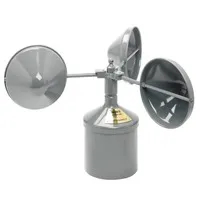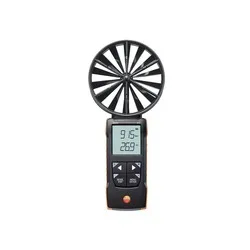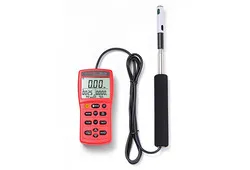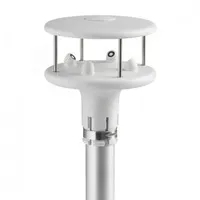The Role of Anemometers in HVAC Systems
In the world of HVAC (Heating, Ventilation, and Air Conditioning) systems, the role of anemometers is indispensable. They play a critical role in HVAC systems by measuring airflow velocity, facilitating energy efficiency optimisation, ventilation control, filter monitoring, system feedback, and occupant comfort enhancement.
Contents |
[edit] Understanding Anemometers
Anemometers come in various types, each suited to specific applications and environments. The primary types of anemometers are below:
Cup Anemometers: These devices consist of three or more small cups mounted on horizontal arms. As the wind or air flows, the cups rotate, and the speed of rotation is directly proportional to the wind speed.
Vane Anemometers: Vane anemometers employ a freely rotating vane or propeller to measure wind speed. Like cup anemometers, they convert wind energy into rotational motion, providing accurate readings of air velocity.
Hot-Wire Anemometers: Operating on the principle of convective heat transfer, hot-wire anemometers utilise a fine wire heated electrically. As air flows over the wire, changes in resistance allow for precise measurement of air velocity.
Ultrasonic Anemometers: These anemometers use ultrasonic signals to determine wind speed and direction. They offer non-intrusive measurement methods, making them suitable for various applications, including HVAC systems.
[edit] The Function of Anemometers in HVAC Systems
In HVAC systems, anemometers play a critical role in several key functions:
Anemometers are used to measure airflow rates within HVAC ducts and systems. Accurate airflow measurements ensure that heating or cooling loads are properly balanced, improving system efficiency and comfort.
By monitoring air velocity and flow, anemometers help HVAC engineers optimise system performance to reduce energy consumption. Properly calibrated anemometers enable precise control of airflow, minimising energy waste.
Anemometers are essential for maintaining indoor air quality by ensuring adequate ventilation rates. They help regulate the flow of fresh air into occupied spaces, preventing the buildup of pollutants and contaminants.
Anemometers can also be used to monitor the performance of air filters within HVAC systems. By measuring airflow before and after the filters, maintenance professionals can assess filter efficiency and schedule replacements as needed.
[edit] Calibration Services for Anemometers
BSRIA provides thorough calibration services for anemometers and air velocity instruments, essential for HVAC system reliability.
Our services meet international standards, issuing traceable calibration certificates. We also offer adjustment and repair services, with on-site calibration options to minimise downtime.
With our expertise spanning decades, our team offers technical support tailored to meet HVAC system requirements.
Anemometers are pivotal for airflow measurement and energy efficiency in HVAC systems. By utilising BSRIA’s calibration services, clients ensure optimal system performance, enhancing comfort and sustainability.
This article appears on the BSRIA blog site as "The Role of Anemometers in HVAC Systems" dated February 29, 2024.
--BSRIA
[edit] Related articles on Designing Buildings
- Adverse weather.
- Airflow.
- Anemometer.
- Balometer.
- Barometer.
- Climate.
- Cold stress.
- Design of isolation rooms for infection control.
- Drought.
- Exceptionally adverse weather.
- Excess cold.
- Extraordinary weather event.
- Extreme weather.
- Extreme weather event.
- Measuring air pressure.
- Overheating.
- Rotating vane anemometer.
- Temporary demountable structures.
- The Role of Anemometers in HVAC Systems.
- Wind.
Featured articles and news
Government consultations for the summer of 2025
A year of Labour, past and present consultations on the environment, the built environment, training and tax.
CMA competitiveness probe of major housing developers
100 million affordable housing contributions committed with further consultation published.
Homes England supports Greencore Homes
42 new build affordable sustainable homes in Oxfordshire.
Zero carbon social housing: unlocking brownfield potential
Seven ZEDpod strategies for brownfield housing success.
CIOB report; a blueprint for SDGs and the built environment
Pairing the Sustainable Development Goals with projects.
Types, tests, standards and fires relating to external cladding
Brief descriptions with an extensive list of fires for review.
Latest Build UK Building Safety Regime explainer published
Key elements in one short, now updated document.
UKGBC launch the UK Climate Resilience Roadmap
First guidance of its kind on direct climate impacts for the built environment and how it can adapt.
CLC Health, Safety and Wellbeing Strategy 2025
Launched by the Minister for Industry to look at fatalities on site, improving mental health and other issues.
One of the most impressive Victorian architects. Book review.
Common Assessment Standard now with building safety
New CAS update now includes mandatory building safety questions.
RTPI leader to become new CIOB Chief Executive Officer
Dr Victoria Hills MRTPI, FICE to take over after Caroline Gumble’s departure.
Social and affordable housing, a long term plan for delivery
The “Delivering a Decade of Renewal for Social and Affordable Housing” strategy sets out future path.
A change to adoptive architecture
Effects of global weather warming on architectural detailing, material choice and human interaction.
The proposed publicly owned and backed subsidiary of Homes England, to facilitate new homes.
How big is the problem and what can we do to mitigate the effects?
Overheating guidance and tools for building designers
A number of cool guides to help with the heat.
The UK's Modern Industrial Strategy: A 10 year plan
Previous consultation criticism, current key elements and general support with some persisting reservations.
Building Safety Regulator reforms
New roles, new staff and a new fast track service pave the way for a single construction regulator.





























